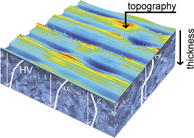Crossref Citations
This article has been cited by the following publications. This list is generated based on data provided by
Crossref.
Smaga, Marek
Skorupski, Robert
Mayer, Patrick
Kirsch, Benjamin
Aurich, Jan C.
Raid, Indek
Seewig, Jörg
Man, Jiří
Eifler, Dietmar
and
Beck, Tilmann
2017.
Influence of surface morphology on fatigue behavior of metastable austenitic stainless steel AISI 347 at ambient temperature and 300°C.
Procedia Structural Integrity,
Vol. 5,
Issue. ,
p.
989.
Smaga, Marek
Boemke, Annika
Daniel, Tobias
Klein, Matthias W.
and
Hénaff, G.
2018.
Metastability and fatigue behavior of austenitic stainless steels.
MATEC Web of Conferences,
Vol. 165,
Issue. ,
p.
04010.
Mayer, Patrick
Kirsch, Benjamin
Müller, Christopher
Hotz, Hendrik
Müller, Ralf
Becker, Steven
von Harbou, Erik
Skorupski, Robert
Boemke, Annika
Smaga, Marek
Eifler, Dietmar
Beck, Tilmann
and
Aurich, Jan C.
2018.
Deformation induced hardening when cryogenic turning,.
CIRP Journal of Manufacturing Science and Technology,
Vol. 23,
Issue. ,
p.
6.
Boemke, Annika
Smaga, Marek
Beck, Tilmann
and
Hénaff, G.
2018.
Influence of surface morphology on the very high cycle fatigue behavior of metastable and stable austenitic Cr-Ni steels.
MATEC Web of Conferences,
Vol. 165,
Issue. ,
p.
20008.
Klein, Matthias W.
Smaga, Marek
and
Beck, Tilmann
2018.
Surface Morphology and Its Influence on Cyclic Deformation Behavior of High-Mn TWIP Steel.
Metals,
Vol. 8,
Issue. 10,
p.
832.
Klein, Matthias W.
Blinn, Bastian
Smaga, Marek
and
Beck, Tilmann
2020.
High cycle fatigue behavior of high-Mn TWIP steel with different surface morphologies.
International Journal of Fatigue,
Vol. 134,
Issue. ,
p.
105499.
Liu, Niancong
Zou, Xing
Yuan, Jia
Wu, Shenghong
and
Chen, Yun
2020.
Performance evaluation of castor oil-ethanol blended coolant under minimum quantity lubrication turning of difficult-to-machine materials.
Journal of Manufacturing Processes,
Vol. 58,
Issue. ,
p.
1.
Hotz, Hendrik
Kirsch, Benjamin
Zhu, Tong
Smaga, Marek
Beck, Tilmann
and
Aurich, Jan C.
2020.
Surface layer hardening of metastable austenitic steel – Comparison of shot peening and cryogenic turning.
Journal of Materials Research and Technology,
Vol. 9,
Issue. 6,
p.
16410.
Glatt, Moritz
Hotz, Hendrik
Kölsch, Patrick
Mukherjee, Avik
Kirsch, Benjamin
and
Aurich, Jan C.
2021.
Predicting the martensite content of metastable austenitic steels after cryogenic turning using machine learning.
The International Journal of Advanced Manufacturing Technology,
Vol. 115,
Issue. 3,
p.
749.
Ostermayer, Pascal
Ankener, Werner
Blinn, Bastian
Smaga, Marek
Eifler, Dietmar
and
Beck, Tilmann
2021.
Analysis of the Subsurface Volume of Differently Finished AISI 52100 by Cyclic Indentation and X‐Ray Diffraction.
steel research international,
Vol. 92,
Issue. 12,
Thammineni, Hari Kisan
Zhu, Tong
Smaga, Marek
Beck, Tilmann
and
Müller, Ralf
2021.
Constitutive modelling of the deformation‐induced martensite transformation observed in metastable austenitic CrNi steels.
PAMM,
Vol. 21,
Issue. 1,
Zhao, Lei
Qi, Xueyan
Xu, Lianyong
Han, Yongdian
Jing, Hongyang
and
Song, Kai
2021.
Tensile mechanical properties, deformation mechanisms, fatigue behaviour and fatigue life of 316H austenitic stainless steel: Effects of grain size.
Fatigue & Fracture of Engineering Materials & Structures,
Vol. 44,
Issue. 2,
p.
533.
Blinn, B.
Greco, S.
Smaga, M.
Zimmermann, M.
Hotz, H.
Müller, D.
Hartig, J.
Kirsch, B.
Aurich, J.C.
and
Beck, T.
2021.
Influence of microstructural defects and the surface topography on the fatigue behavior of “additively‐subtractively” manufactured specimens made of AISI 316L.
Materialwissenschaft und Werkstofftechnik,
Vol. 52,
Issue. 5,
p.
561.
Smaga, Marek
Boemke, Annika
Eifler, Dietmar
and
Beck, Tilmann
2022.
Very High Cycle Fatigue Behavior of Austenitic Stainless Steels with Different Surface Morphologies.
Metals,
Vol. 12,
Issue. 11,
p.
1877.
Thammineni, Hari Kisan
Zhu, Tong
Smaga, Marek
Beck, Tilmann
and
Müller, Ralf
2023.
Numerical modelling of stress‐strain response and deformation‐induced martensite in metastable austenitic stainless steels under monotonic tensile loading.
PAMM,
Vol. 22,
Issue. 1,
Xie, Ang
Chen, Shenghu
and
Rong, Lijian
2023.
Dynamic Strain Aging Induced by Synergistic Effects of Deformation-Induced Martensite and Deformation Twins in Fe–Cr–Ni Metastable Austenitic Stainless Steel.
Metallurgical and Materials Transactions A,
Vol. 54,
Issue. 12,
p.
4592.
Veile, Georg
Regitz, Elen
Smaga, Marek
Weihe, Stefan
and
Beck, Tillmann
2024.
Investigations of Metallurgical Differences in AISI 347 and Their Influence on Deformation and Transformation Behaviour and Resulting Fatigue Life.
Materials,
Vol. 17,
Issue. 18,
p.
4543.
Beck, Tilmann
Smaga, Marek
Antonyuk, Sergiy
Eifler, Dietmar
Müller, Ralf
Urbassek, Herbert M.
and
Zhu, Tong
2024.
Component Surfaces.
p.
257.
Kopnarski, Michael
Beck, Tilmann
Diederichs, Stella
Kerscher, Eberhard
Seewig, Jörg
and
Smaga, Marek
2024.
Component Surfaces.
p.
9.




